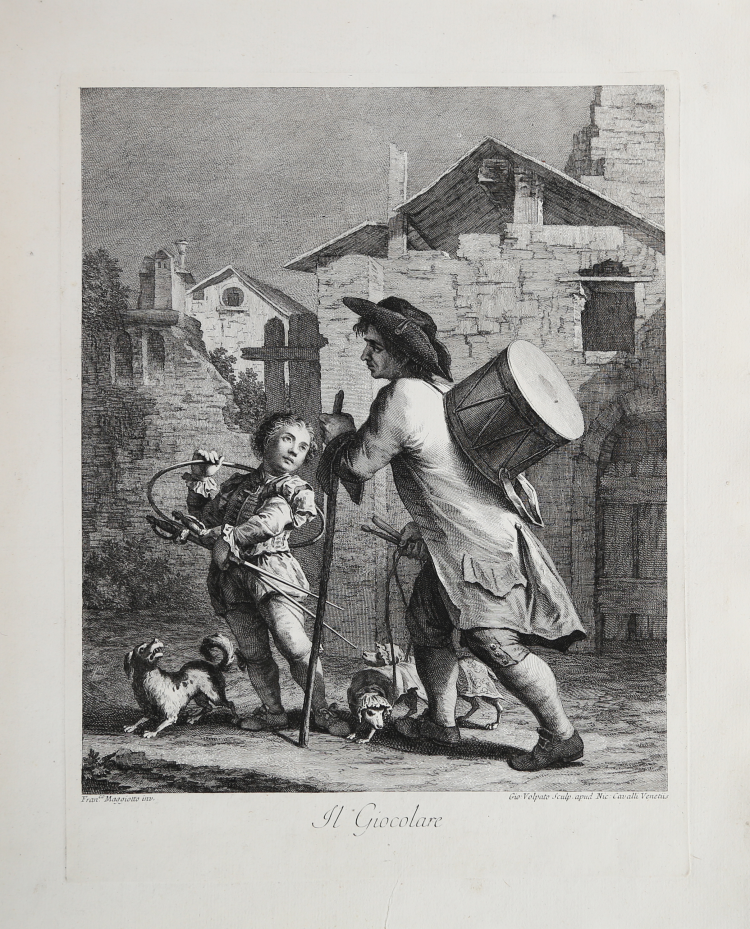




| Reference: | S45924 |
| Author | Giovanni VOLPATO |
| Year: | 1766 ca. |
| Measures: | 290 x 375 mm |



| Reference: | S45924 |
| Author | Giovanni VOLPATO |
| Year: | 1766 ca. |
| Measures: | 290 x 375 mm |
A street entertainer on the road walking past derelict buildings with a drum (tabor) on his back holding a pipe and drumstick in his right hand and a long walking stick in his left. He is accompanied by two costumed dogs on leads and his boy in Renaissance costume carrying a hoop and two swords. A third dog leads the way.
Etching and engraving, circa 1765, lettered with title and 'Fran.co Maggiotto inv.' at right Gio. Volpato Sculp. appo Nic. Cavalli Venetiis'.
Example of the first state of two described by Succi.
From a series of 12 street trades, all engraved by Volpato (cf. Marini 57 to 68) after Francesco Maggiotto for the publisher Niccolò Cavalli.
The series is called le Arti per via consists of 12 plates. Volpato, a native of Bassano (1740 - Rome 1803), was one of the most valuable engravers of the 18th-century Venetian decorative print; he always depicted scenes of popular settings with skill and vividness, but he also devoted himself to the 'engraving of architectural capriccios and Raphael's famous loggias at the Vatican.
Published around 1766 by Nicolò Cavalli (1730-1822), in whose workshop, specializing in the production of genre scenes, also worked Pellegrino De Col (1737-1812) and Francesco del Pedro (1740-1806), the twelve sheets of the Arti per via, derived from drawings by Francesco Maggiotto, represent the most interesting series of Volpato's Venetian period because of the popular character and the expressive vividness of the tasty little scenes.
The plates were purchased, before 1824, by the Milanese publisher Vallardi.
A magnific impression, printed on contemporary laid pape, with margins, in excellent condition.
Bibliografia
G. Marini, Giovanni Volpato 1735-1803, n. 64; D. Succi, La Serenissima nello specchio di rame, pag. 775, Volpato 8, I/II.
Giovanni VOLPATO (Angarano di Bassano, 1740 - Roma, 1803)
|
Italian engraver. In 1760 he entered the famous copperplate printworks of Giambattista Remondini in Bassano and, under the guidance of Antonio Baratti, learnt the art of engraving and etching. During this early period he engraved, signing himself Jean Renard, four Rustic Capricci after Giovanni Battista Piazzetta, the Four Parts of the World after Jacopo Amigoni, the Four Ages of Man after Andrea Zucchi and the portrait of Giambattista Morgagni. On the invitation of Francesco Bartolozzi, who had noted his talent during a visit to Bassano, he moved to Venice in 1762 and was thus able to refine his technique while maintaining his connection with the Remondini concern as a technical consultant and commercial adviser.
|
Giovanni VOLPATO (Angarano di Bassano, 1740 - Roma, 1803)
|
Italian engraver. In 1760 he entered the famous copperplate printworks of Giambattista Remondini in Bassano and, under the guidance of Antonio Baratti, learnt the art of engraving and etching. During this early period he engraved, signing himself Jean Renard, four Rustic Capricci after Giovanni Battista Piazzetta, the Four Parts of the World after Jacopo Amigoni, the Four Ages of Man after Andrea Zucchi and the portrait of Giambattista Morgagni. On the invitation of Francesco Bartolozzi, who had noted his talent during a visit to Bassano, he moved to Venice in 1762 and was thus able to refine his technique while maintaining his connection with the Remondini concern as a technical consultant and commercial adviser.
|